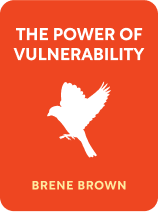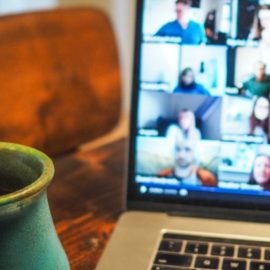

This article is an excerpt from the Shortform book guide to "The Power Of Vulnerability" by Brené Brown. Shortform has the world's best summaries and analyses of books you should be reading.
Like this article? Sign up for a free trial here .
Why are creativity, play, and rest important to wholehearted living? Why should you stop using exhaustion as a status symbol? What are some of Brené Brown’s methods to release stress?
According to Brené Brown, creativity, play, and rest are wholehearted behaviors that will promote a healthy mind and body. Society has led people to believe that these behaviors are childish and after a certain age, these abilities are scoffed at or degraded.
Keep reading to learn why adults should re-embrace their creative sides.
5 Wholehearted Behaviors (Practices #6-10)
This article covers the final five practices for wholehearted living from Brené Brown—creativity, rest, and play. These practices promote action and behavior. By engaging with these activities, you can lower your inhibitions, let go of the need for validation, and take care of your mind and body.
Practice #6: Rediscover Creativity and Abandon Comparison
According to Brené Brown creativity is essential to wholehearted living, acting as an outlet for emotional expression and a generator for innovation. Many scoff at art, calling it self-indulgent or childish. However, unused creativity often transforms into pent-up, negative emotions such as guilt, rage, or judgment. In addition to emotional build-up, a lack of creativity has contributed to the “innovation problem” many businesses have experienced in the 21st century.
Everyone has the capacity to be creative. However, many people experience shame surrounding art at a young age, leading them to abandon their creative pursuits early on. In fact, because art requires immense vulnerability—often in a public setting—creativity is one of the most common shame triggers.
What causes this common source of shame? Comparison. In the United States, students only have creative freedom until around the third grade, at which point teachers begin comparing students’ work. When this happens, many students are told that they’re “not good enough,” and should move on to “more realistic” pursuits.
Sometimes this is taken to an extreme. For example, if your teacher ridiculed your painting, you’d likely be hesitant to jump back into creative pursuits. If that apprehension continued through your developmental years, you may become a grown adult who believes they lack the capacity for creativity.
If you’ve lost touch with your creativity, consider the following:
Experiment With Artistic Ventures
There are many ways to do this, including taking a painting class, starting voice lessons, or dancing with your significant other. There is no right or wrong way to be creative. It’s about playing with different mediums and finding what works best for you.
Practice Overcoming the Fear of Comparison
Comparison leads to the question, “What’s the point if I’m never going to be ‘good enough’?” To combat this feeling, remember that creativity isn’t about being “better” than someone else. It’s about a willingness to be vulnerable and expressive. The more you engage with your own creativity, the easier it will be to abandon comparison.
Practice #7: Be Willing to Play and Rest, and Stop Using Exhaustion as a Status Symbol
Most adults struggle with the concepts of play and rest because of the stigma of “laziness.” Particularly in American culture (where work and identity are often linked), exhaustion in the name of productivity has become a “badge of honor” for many. For example, if you worked until midnight on a project and only slept for three hours, you may share that information with your colleagues as a point of pride.
However, research has shown that play and rest are essential parts of wholehearted living and lead to higher rates of productivity than overworking.
Play
“Play” has three elements:
- It’s time spent without purpose.
- It’s something you don’t want to end.
- It leads to a loss of self-consciousness.
Play helps alleviate stress and generate joy as you allow yourself to get lost in an activity without stakes. Few adults willingly engage in play out of fear of being viewed as “childish.” However, a lack of play is directly related to increased levels of depression and aggression. In fact, some studies have shown a direct correlation between violence and a lack of play.
For example, in 1966, Charles Whitman, a student at the University of Texas, opened fire on students from the top of UT Tower. Following the attack, psychiatrist Stuart Brown studied Whitman’s history for clues to what led him to carry out such a horrific act. He discovered that Whitman’s father never allowed him to play and demanded perfection, a fact that Brown believes led to the repressed rage that led to the attacks.
(Shortform note: Read more about Stuart Brown’s perspective on Charles Whitman here.)
To begin to play, consider the following:
Find your personal definition of play.
Play means something different for everyone. For example, some people love games, some love recreational sports, and some love to dance in their kitchen. There isn’t a right or a wrong way to play as long as the activity fits within the properties of play:
- Find the things that bring you joy and relaxation. Be honest with yourself. You don’t have to love the things that the people around you love.
- Once you’ve found your favorite ways to play, discover the things that overlap with your family and friends. If you can find one or two activities that you can do as a group, you’ll be able to engage in play with people you love, allowing you to build connection through play.
Contest is part of play, but competition isn’t.
A contest consists of a challenge that involves putting people at odds with one another. Competition takes that one step further, requiring a winner and a loser. Competition creates pressure to come out on top and attaches self-worth to victory.
For example, a friendly game of Monopoly can be a contest as long as no one really cares who wins or loses. However, the moment that winning becomes everything, it turns into a competition, creating stress and tension.
Animals and Contest
Many animals engage in playful contests with one another. They’ll even handicap themselves to make playtime last longer. For example, in a wrestling match between two dogs, the stronger one will often allow the weaker one to gain the occasional advantage so they can play longer.
In most cases, animals don’t engage in competition unless there are actual stakes involved. For example, lions engaged in a fight to see who will control territory is a competition. The fight requires a winner and a loser and will dictate the future of the pride.
Rest
Many adults are in “sleep debt,” meaning they’ve gone more than two consecutive nights with less than seven hours of sleep. While a significant number of people believe they’re fine living with sleep debt, researchers have discovered that no one functions at their peak without sufficient rest. In fact, sleep deprivation has been linked to:
- Cancer
- Obesity
- Diabetes
- Human-error tragedies (particularly car accidents)
Adults in sleep debt often fear being called “lazy,” leading them to work overtime in the name of productivity. There are two common excuses that come from this perspective:
- “I have to get things done right now.” This excuse often leads people to rush in an effort to get their work done quickly, leading to error or subpar output. Great work takes time and requires intermittent rest throughout the process.
- “I can rest when I’m done.” More often than not, people using this excuse are always working on new projects, meaning that they’ll never be “done.” This mindset often leads to late-life regrets of not spending enough time with family and friends because of work and exhaustion.
To embrace rest, accept that you’re allowed to pause and relax for your well-being. Your value as a human being isn’t attached to exhaustion or productivity. Overworking prevents you from checking-in with yourself and making sure that you’re healthy, which can have devastating results in the long-term.
Practice #8: Embrace Calm and Stillness by Releasing Anxiety
Anxiety can quickly take over your life if you don’t actively fight against it, especially when it’s caused by a shame trigger. In addition to the personal stress anxiety can cause, it quickly spreads to the people around you, causing tension to quickly rise. For example, if someone walks into a meeting carrying anxious energy, that energy can easily spread to the rest of the room, making the meeting less effective and more stressful.
There are two kinds of natural responses to anxiety:
- Over-functioning. Some people respond to anxiety with excessive action or micromanagement. For these people, it’s easier to do something than sit in their anxiety, often leading to problems with perfectionism. For example, if an over-functioner is feeling anxious about an upcoming presentation, they may review their material 20 times the night before and demand that their team put in extra hours to make everything perfect.
- Under-functioning. Some people respond to anxiety by shutting down. For these people, it’s easier to retreat than engage with their anxiety, often leading to problems with reliability. For example, if an under-functioner is feeling anxious about an upcoming presentation, they may opt to ignore their responsibilities and binge-watch a TV show instead.
Both tendencies come from the need for numbing. Over-functioners use work to numb their emotions, while under-functioners use distraction. These pieces of emotional armor prevent you from addressing the source of your anxiety, exacerbating the problem. Know which tendency you fall into and avoid the associated behaviors. If you’re not sure which tendency you fall into, ask your friends and family. They can give you an outside perspective.
Once you have a grasp on your tendencies, address your anxiety by finding the source of your stress. This will lead to one of two realizations:
- You have control over the source of your anxiety. In this situation, work to solve any problems associated with the anxiety you’re feeling, being kind to yourself in the process.
- You have no control over the source of your anxiety. In this situation, you can’t do anything to change your circumstances. While this may seem like a stressor, it takes the burden off of your shoulders and can help you let go of your anxiety.
Birth Order and Anxious Tendencies
Researchers have discovered that birth order and anxious tendencies often have a direct correlation. First-born children and first-born females tend to be over-functioners because they’ve had more responsibilities in childhood, inflating their sense of importance. Conversely, younger siblings tend to be under-functioners because they’ve had things done for them by older siblings, lessening their sense of responsibility.
Calm and Stillness
Calm is the discovery of perspective through mindfulness. Calmness is the antidote to anxiety because it allows you to look at the source of your anxiety in a reasonable way. For example, if you’re feeling anxious about an upcoming date, a moment of calm can lead to the realization that the stakes of a single date are relatively low, allowing you to enter the date collected and emotionally available.
Calmness requires practice, especially in high-stress situations. When your anxiety is triggered, use the following steps as a guide to calmness:
- Breathe. Take a few deep breaths and focus on nothing but your breathing for a moment.
- Respond to anxiety triggers with questions. This will give you a moment to calm down and gauge the severity of the situation.
- After thinking through the situation, ask yourself, “Is there enough information to justify an anxious meltdown?”
- If the answer to that is, “Yes,” ask yourself, “Will melting down be helpful?” In almost every situation, the answer to this final question will be, “No.”
For example, a co-worker approaches you and tells you that they heard that your company is going to start laying people off because of budget cuts. After a few deep breaths, you ask the following:
- Did you hear this from a reliable source?
- Are they positive this is going to happen?
Had they answered, “No,” to either question, there wouldn’t be a reason to be anxious, but, unfortunately, they answer, “Yes,” to both, so you then ask yourself:
- Is there enough information to justify an anxious meltdown?
- Will melting down be helpful?
Even if you answer, “Yes,” to the first question, you recognize that melting down isn’t going to be helpful. Because you have no power over the outcome, you take a few more deep breaths and continue to go about your day.
Practice #9: Find Meaningful Work and Detach Yourself From Expectation and Self-Doubt
Meaningful work is any work that you’re passionate about. While some people have the privilege of making money doing the thing they love, most people have to find this work outside of their careers. This could be through volunteering, finding a hobby, or joining local organizations. For example, if you love performing, you could participate in a local choir or community theater.
Many people associate “work” with money, especially in American culture. This causes many people to avoid pursuing their passions because they fear it will take time away from “real work.” For example, an accountant may ignore their love of writing because they’re afraid it will take time away from the accounting work that brings home a paycheck.
The first step to engaging in meaningful work is to let go of expectations, especially around money. If something is meaningful to you, then it’s important. You don’t have to make money doing it. While financial factors may keep you from investing all of your time into your passions, finding some time for meaningful work will provide fulfillment and purpose.
On the other side, if you have a career in something that you’re passionate about, embrace that the work isn’t always going to feel fulfilling. It’s okay for your work to occasionally feel like a chore. You can find meaning in your work and dislike aspects of the process. If you’re able to make money doing something that you love, it’s usually worth the moments of frustration.
Work and Identity in America
In the USA, people often associate identity with career. In fact, one of the first questions Americans ask when they meet someone is, “What do you do?” When people respond, they usually say the thing that makes them money, not necessarily the thing that brings them joy. For example, a banker who has a passion for making handmade furniture would likely respond to the question, “What do you do?” with “I’m a banker,” not “I make furniture.”
While it may not be the norm in American society, it can be fulfilling to identify with the things that bring you joy instead of the career that provides an income, especially if those two things don’t align. Next time someone asks you, “What do you do?”, try responding with your passion instead of your career, and see how that changes the dynamic of the conversation.
Practice #10: Release Your Inhibitions by Engaging in Laughter, Singing, and Dancing
Laughing, singing, or dancing around other people requires immense vulnerability but also breaks down barriers, creates belonging, and offers a sense of freedom. Unfortunately, people often avoid these activities because of prevailing social and gender norms:
- Women are often told they’re being too loud and need to be more reserved.
- Men are often told that activities such as laughing, singing, and dancing show weakness, especially when they’re not associated with a “talent.”
These shame triggers lead people to silence themselves as they try to fit into a mold that others have built for them—a restrictive and unhealthy behavior. For example, if someone’s at a concert and wants to sing along with the artist, but someone told them that they should never sing, they’ll likely stay silent, falling victim to their inhibitions and shame.
To release yourself from your inhibitions, embrace “goofiness.” Sing with your loved ones. Dance in your living room. Laugh with your friends. Don’t allow societal demands to limit your joy.
In addition to your personal freedom, advocate for the people that you love. For example, if your child begins dancing in the middle of a store, praise their bravery and creativity instead of demanding that they stop. While others may judge them for their actions, that’s their problem, not yours or your child’s.
Using the Practices for Wholehearted Living
Wholeheartedness is something you will always work on. As you begin to implement these practices into your life, keep the following in mind:
- Accept that you will never be perfect. You will make mistakes. When you do, admit that you were wrong and move on. Don’t attach stumbles to your self-worth.
- Living your best life is more important than fearing judgment. Living wholeheartedly may cause some friction with people who don’t understand, but their personal shame shouldn’t limit you from living wholeheartedly.
Be bold. Wholehearted living can be scary, and it won’t always work out. However, pursuing fulfillment and joy is why we exist—and the reward is worth the risk.

———End of Preview———
Like what you just read? Read the rest of the world's best book summary and analysis of Brené Brown's "The Power Of Vulnerability" at Shortform .
Here's what you'll find in our full The Power Of Vulnerability summary :
- The 10 practices that you can use to embrace vulnerability and start living a wholehearted life
- Why thinking that you're never "enough" is dangerous
- The most common sources of shame and how to overcome them






